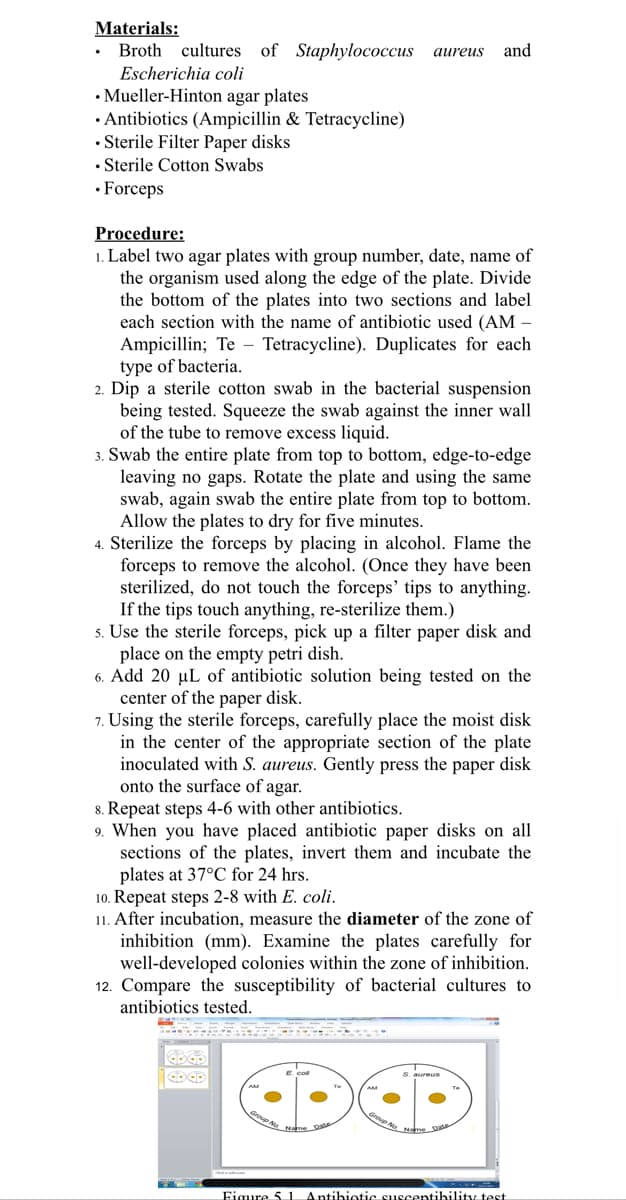For a laboratory exercise of antibiotic susceptibility test in a disk-diffusion method. What are the concentrations of antibiotic applied in the test?
For a laboratory exercise of antibiotic susceptibility test in a disk-diffusion method. What are the concentrations of antibiotic applied in the test?
Basic Clinical Laboratory Techniques 6E
6th Edition
ISBN:9781133893943
Author:ESTRIDGE
Publisher:ESTRIDGE
Chapter7: Basic Clinical Microbiology
Section7.2: Bacteriology Specimen Collection And Processing
Problem 3.1CS
Related questions
Question
For a laboratory exercise of antibiotic susceptibility test in a disk-diffusion method.
What are the concentrations of antibiotic applied in the test?

Transcribed Image Text:Materials:
Broth cultures of Staphylococcus aureus and
Escherichia coli
• Mueller-Hinton agar plates
. Antibiotics (Ampicillin & Tetracycline)
• Sterile Filter Paper disks
• Sterile Cotton Swabs
• Forceps
Procedure:
1. Label two agar plates with group number, date, name of
the organism used along the edge of the plate. Divide
the bottom of the plates into two sections and label
each section with the name of antibiotic used (AM-
Ampicillin; Te Tetracycline). Duplicates for each
type of bacteria.
2. Dip a sterile cotton swab in the bacterial suspension
being tested. Squeeze the swab against the inner wall
of the tube to remove excess liquid.
3. Swab the entire plate from top to bottom, edge-to-edge
leaving no gaps. Rotate the plate and using the same
swab, again swab the entire plate from top to bottom.
Allow the plates to dry for five minutes.
4. Sterilize the forceps by placing in alcohol. Flame the
forceps to remove the alcohol. (Once they have been
sterilized, do not touch the forceps' tips to anything.
If the tips touch anything, re-sterilize them.)
5. Use the sterile forceps, pick up a filter paper disk and
place on the empty petri dish.
6. Add 20 µL of antibiotic solution being tested on the
center of the paper disk.
7. Using the sterile forceps, carefully place the moist disk
in the center of the appropriate section of the plate
inoculated with S. aureus. Gently press the paper disk
onto the surface of agar.
8. Repeat steps 4-6 with other antibiotics.
9. When you have placed antibiotic paper disks on all
sections of the plates, invert them and incubate the
plates at 37°C for 24
10. Repeat steps 2-8 with E. coli.
11. After incubation, measure the diameter of the zone of
inhibition (mm). Examine the plates carefully for
well-developed colonies within the zone of inhibition.
12. Compare the susceptibility of bacterial cultures to
antibiotics tested.
apap
EDED
Group Ane Date
Figure 5.1 Antibiotic susceptibility test.
Expert Solution
This question has been solved!
Explore an expertly crafted, step-by-step solution for a thorough understanding of key concepts.
Step by step
Solved in 3 steps

Knowledge Booster
Learn more about
Need a deep-dive on the concept behind this application? Look no further. Learn more about this topic, biology and related others by exploring similar questions and additional content below.Recommended textbooks for you


Microbiology for Surgical Technologists (MindTap …
Biology
ISBN:
9781111306663
Author:
Margaret Rodriguez, Paul Price
Publisher:
Cengage Learning

Basic Clinical Lab Competencies for Respiratory C…
Nursing
ISBN:
9781285244662
Author:
White
Publisher:
Cengage


Microbiology for Surgical Technologists (MindTap …
Biology
ISBN:
9781111306663
Author:
Margaret Rodriguez, Paul Price
Publisher:
Cengage Learning

Basic Clinical Lab Competencies for Respiratory C…
Nursing
ISBN:
9781285244662
Author:
White
Publisher:
Cengage